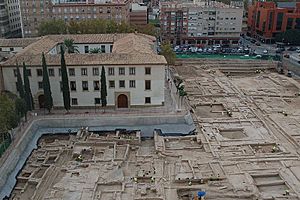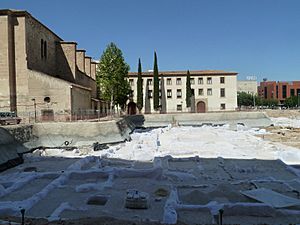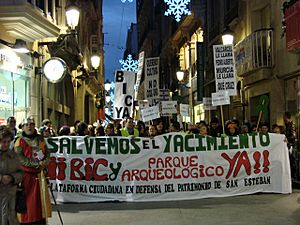Al-Andalusian palatial complex and neighborhood of San Esteban facts for kids
The Al-Andalusian palatial complex and neighborhood of San Esteban is an amazing archaeological site in the city of Murcia, Spain. It's located in what used to be the Garden of San Esteban, right next to the Palacio de San Esteban building. This special site covers over 10,000 square meters!
Archaeologists are still digging here, but they've already found incredible things. They're learning how this part of the city has changed from ancient Islamic times until today. The site shows remains of large country homes, palaces, huge gardens, and even a religious area with a burial ground (called a necropolis) and a small mosque or prayer room.
Contents
History of the Site
The discoveries at San Esteban mostly show what the Islamic neighborhood looked like in the 1200s. Some parts might even be from the late 1000s or 1100s. This area was known as the Arrabal of la Arrixaca Nueva, which means the "new outer part of the city" in the north.
People used to think this outer area was mainly for large country homes called almunias. These were like big farms that grew lots of food and had beautiful gardens for relaxing.
Muslim Influence in Murcia
Muslim people had a huge impact on farming in Murcia, especially with how they managed water. They used old Roman water systems but also added new canals and water-wheels. They even controlled the Segura River like the Egyptians did with the Nile River. These smart farming methods led to a big boom in agriculture!
Muslim farmers brought many new crops to Spain, like rice, citrus fruits, aubergines (eggplants), artichokes, figs, dates, apricots, sugar cane, and different types of wheat. They also helped the textile industry grow by harvesting cotton and flax.
Christian Reconquest
Things changed when Christian rulers took over. In 1243, King Ferdinand III of Castile made Murcia a protected area. Many Christian people moved in, encouraged by the king to create a loyal Christian population.
This led to a revolt by the local Muslim people in 1264. King James I of Aragon stopped the revolt in 1266 and brought even more Christian settlers. Soon, the Christian population became dominant, and many Muslim residents had to move out of the main city area (called the medina).
Archaeological Discoveries
The recent digs have changed what we thought about this area. It seems that more people started living in the Arrabal of la Arrixaca Nueva as early as the 1100s. The city began to spread out from the old city walls.
Past excavations under the Palacio de San Esteban had hinted at an Islamic palace there. The new discoveries in the Garden of San Esteban show that this palace likely led to many homes and buildings growing up around it.
Archaeologists have learned a lot about Murcia's city layout from digs over the past 20 years. What they found at San Esteban is similar to other parts of the city. The houses themselves were not super fancy, but what makes this site special is that it gives us a wide view of a large urban area from that time.
What the Site Shows Us
Because this area was an open space, it allowed for well-planned streets that were quite wide for the city of Murcia. Like other Islamic cities, it had a good system for drains and sewers. This kind of public water system was actually lost after the Christian conquest and wasn't fully brought back to Murcia until the 1900s!
Even though the building materials were simple, the homes followed typical Islamic designs. They had central courtyards with gardens, the main living room was usually on the north side, and the entrance from the street was twisted to give people more privacy inside the house. This makes them great examples of traditional Islamic homes in Murcia from the 1100s and 1200s.
Important Buildings
While these homes weren't huge palaces like the Monasterio de Santa Clara la Real, they were large enough to belong to wealthy people. These might have been important officials connected to the palace believed to be under the current Palacio de San Esteban. Some buildings might have even been public places, like an inn (called a "funduk") or a school (called a "madrasa").
Besides homes, there's also a religious area in the northwest part of the site. It includes a necropolis (burial ground) and possibly a small oratory or mosque that served the neighborhood in the late 1200s.
What Happened After the Excavations
The City Hall of Murcia originally wanted to build an underground car park in the Garden of San Esteban. But when archaeologists started finding all these amazing remains, plans changed. They even thought about carefully moving the entire Islamic neighborhood and putting it back together at ground level!
Rules for protecting historical sites in Murcia meant that the car park couldn't be built if too many important remains were found. Since almost the entire area planned for the car park had archaeological finds, the regional government decided to stop the car park project completely.
This change meant the archaeological digs, which were paid for by the construction company, were paused. The company then started a new project focused on saving and displaying the excavated site, as well as the parts still to be dug up.
The government also began the process of declaring the San Esteban site a Bien de Interés Cultural (BIC), which means "Asset of Cultural Interest." This is a special protection status for important heritage sites.
During this time, experts are working to decide the final plan for the site. They are collecting all the information, figuring out how to protect and restore the remains, and planning how to show them to the public. A team of experts, chosen for their knowledge of Islamic history and archaeology, is helping with these important decisions.
Citizen Movement to Save the Site
On November 27, 2009, about 300 artists, writers, and painters gathered in Murcia. They created a "Manifesto for San Esteban," which was a public statement. They decided to report what was happening at the site, and their complaints led to the work being stopped.
After this, more and more people became aware of the site and protested against building the underground car park. A local politician, Carlos Rodríguez Ibáñez, created a Facebook group called "Yacimiento de San Esteban" (San Esteban Site). In just a few days, it had over 20,000 members! News outlets talked about the Facebook group and its many followers.
A professor, Javier García del Toro, started holding meetings every Sunday near the site to teach people about its importance. He organized a human chain, where people linked arms around the site, calling it "Abraza San Esteban" (Embrace San Esteban).
This citizen movement led to a public group called "Plataforma Ciudadana" (Citizen Platform) with the slogan "Abraza San Esteban." They protested wearing green jackets and holding umbrellas to show that the site was being left unprotected from the weather. Members even chained themselves to the site and protested in other areas of Murcia to highlight the site's neglected state.
On December 19, 2009, about 5,000 people marched from the City Hall through the streets of Murcia, ending at the San Esteban site. There, they read the "Manifesto for San Esteban" aloud.
Articles on the site
- Gold mine (12/08/2009) (in Spanish)
- Archaeological site yes, underground parking car no (12/10/2009) (in Spanish)
- Manifesto (12/19/2009) (in Spanish)
- Red Heritage List (01/12/2010) (in Spanish)
- 61 days of abandonment (02/09/2010) (in Spanish)
- Exhibition on the site (28/04/2010) (in Spanish)
- Guided visits (04/30/2010) (in Spanish)
- Covering of San Esteban (07/30/2010) (in Spanish)
- Contests of ideas (07/08/2010) (in Spanish)
See also
 In Spanish: Yacimiento arqueológico de San Esteban para niños
In Spanish: Yacimiento arqueológico de San Esteban para niños






